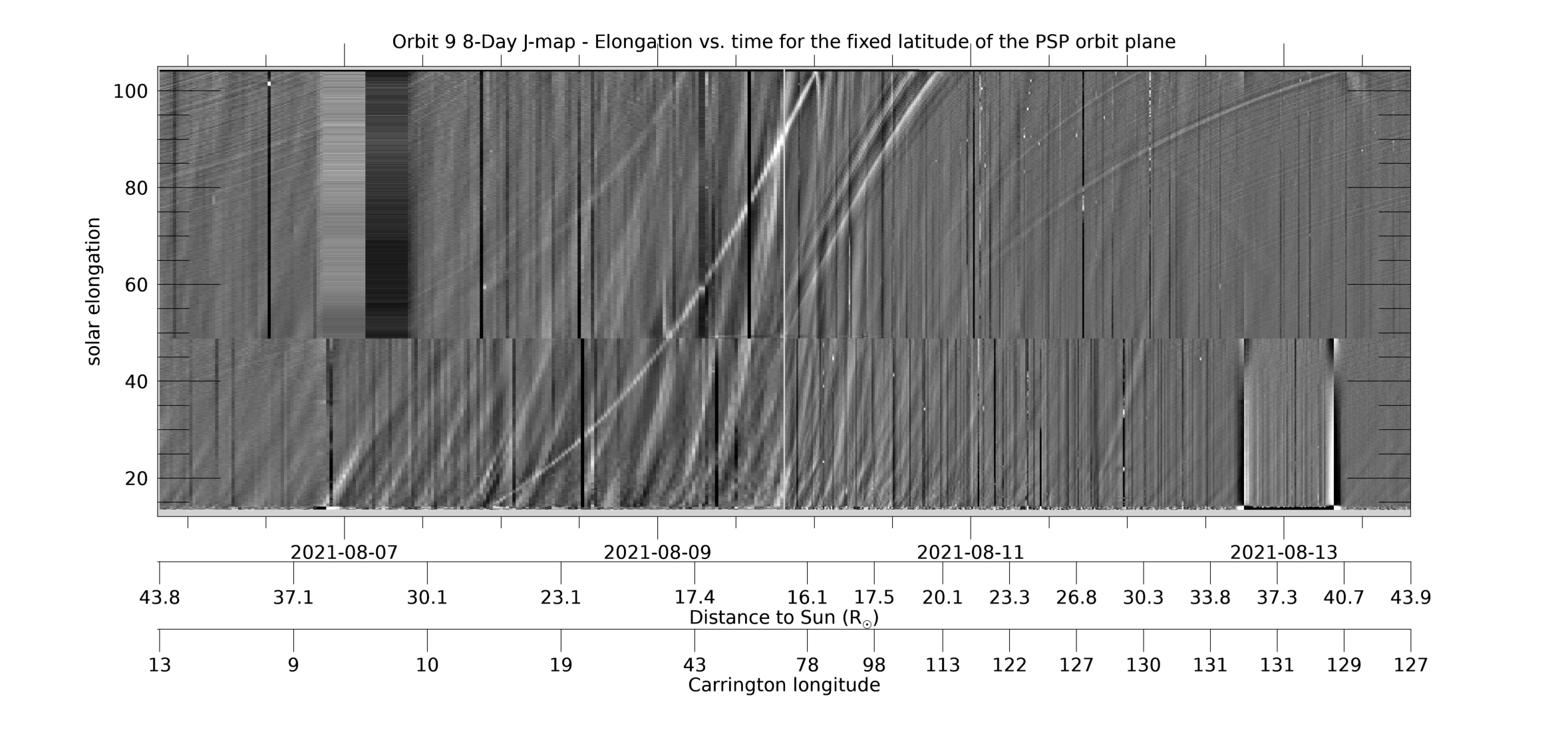Encounter 9 (2021-08-04 - 2021-08-15, with limited additional data 2021-06-20 - 2021-09-10)
This animation shows all L3 WISPR full-field observations from the ninth PSP Mission Encounter (08-04-2021 - 08-15-2021). We have superimposed a grid showing helioprojective longitude and latitude, and a scale representation of the size and location of the Sun in the observations using the SDO/HMI Carrington map for this time period. The velocity and distance metrics displayed on the movies correspond respectively to the spacecraft's heliocentric velocity in kilometers per second, and its distance from the Sun's center in units of solar radii (where 1 solar radius = 695,700km). The "FOV Range" label provides the plane-of-sky distance limits of the inner and outermost edges of the fields of view, in units of solar radii. The horizontal blue line indicates the orbital plane of PSP. The timespan of this composite movie covers only the nominal science window when the spacecraft was within 0.25 au; a limited amount of data outside of this range may be available at the below links.
You can download this movie directly as a 47MB mp4 file. It is also available as a 234MB mp4 file, processed via the LW Algorithm developed by Dr. Guillermo Stenborg (JHUAPL) and detailed in Appendix A of Howard et al. 2022 (ApJ, 936, id.43. DOI 10.3847/1538-4357/ac7ff5).
[Credit: NASA/NRL/JHUAPL. Movie processed/compiled by Guillermo Stenborg (JHUAPL) and Brendan Gallagher (NRL). SDO inset courtesy of NASA/SDO and the AIA, EVE, and HMI science teams.]
Solar Features
2021/08/05 12:30 CME
2021/08/07 07:00 Streamer Blob
2021/08/07 11:30 Streamer Blob
2021/08/07 20:00 Streamer Blob
2021/08/08 18:30 Streamer Blob
2021/08/09 19:00 HCS Crossing
2021/08/11 18:00 Streamer Blob
Miscellaneous Notes:
- A new straylight model was used in the outer telescope, accounting for the straylight levels diminishing near perihelion, relative to the extrapolation of the previous model based only on data from larger radial distances.
- There were a variety of issues with bias subtraction that are visible in the L1 data, but have been resolved in Level 2 images.
- WTS Data: A remnant column to column pattern on the order of 1% of the total image signal was visible. This steady signal throughout the WTS data was isolated from the actual signal and subtracted. This pattern can be removed in the Level 1 images using the image found in $SSW/wispr/calibration/e9wtsbias.fits
- WISPR-I: Between August 12 17:37 and August 13 07:07 a low gain bias image was subtracted from high gain images. Because of this a leftover bias pattern is visible in the L1 images. This pattern was calculated and removed from the Level 2 images. It can be removed from Level 1 images using the image found in $SSW/wispr/calibration/202108_bias.fits
- WISPR-O: Beginning at 07:37 on August 11 and lasting for 24 hours, the bias image subtracted from the outer telescope was taken at a different setting on the gain ladder than the actual images. This left both a noticeable bias patten and an extra intensity from the bias offset on the image. This was removed by subtracting the signal remaining in the masked pixels of the detector and multiplying the image by a constant factor to line the intensities up with the sequence before and after the impacted images
Comets
No comets were observed during the nominal encounter
Planets
The following planets were visible in the encounter, all moving left-to-right. The following dates refer to their visibility only in the WISPR-Inner camera, and assumes they transit the outer camera too:
- Mercury, 2021-08-05
- Mars, 2021-08-05 ("below" Mercury)
- Venus, 2021-08-08
- Saturn, 2021-08-09 (enters ~20UT)
- Earth, 2021-08-09 (enters ~23UT, "behind" Saturn)
- Jupiter, 2021-08-10 (enters ~02UT, "behind" Earth)
Encounter 9 Data Products
- Encounter 9 Level-2 FITS (12.0 Gb zip file)
- Encounter 9 Level-2 High-cadence FITS (3.8 Gb zip file)
- Encounter 9 Level-2b FITS, Background Models (5.8 Gb zip file)
- Encounter 9 Level-3 FITS (5.8 Gb zip file)
- Encounter 9 L1 and L2 Summary Files (<1 MB zip file)
- Encounter 9 Level-3 PNGs, Inner camera (150 MB zip file)
- Encounter 9 Level-3 PNGs, Outer camera (149 MB zip file)
- Encounter 9, Inner mpg, 480x512px (43 MB)
- Encounter 9, Inner mpg, 960x1024px (249 MB)
- Encounter 9, Outer mpg, 480x512px (101 MB)
- Encounter 9, Outer mpg, 960x1024px (509 MB)
- Encounter 9, Inner mvi, 480x512px (230 MB)
- Encounter 9, Inner mvi, 960x1024px (918 MB)
- Encounter 9, Outer mvi, 480x512px (196 MB)
- Encounter 9, Outer mvi, 960x1024px (783 MB)
Encounter 09 J-maps, R-maps, and Lat-maps
The following data products are J-maps, R-maps, and Lat-maps for this Encounter, provided by NASA/JPL/CALTECH. Some reference on the use and interpretation of elongation versus time maps (aka J-maps) are Sheeley et al., 1999 ( DOI: 10.1029/1999JA900308), Sheeley et al., 2008 ( DOI: 10.1086/529020) and Rouillard et al., 2010 ( DOI: 10.1029/2009JA014472). A reference for the creation and use of R-maps is Nindos et al., 2021 (DOI: 10.1051/0004-6361/202039414). Various ways of constructing Latitude versus Time maps are described in Poirier et al., 2020 (DOI: 10.3847/1538-4365/ab6324), Nindos et al., 2021 (DOI: 10.1051/0004-6361/202039414), and Liewer et al., 2023 (DOI: /10.3847/1538-4357/acc8c7).
[ABOVE] This 8-day WISPR J-map shows solar elongation (angle from the Sun center) versus time at a fixed latitude measured relative to the PSP-Venus orbit plane. It is created from composite LW-processed full field-of-view (FOV) composite images such as those in the LW movie above, in which the PSP-Venus orbit plane is marked with a blue line. For each image (each time), data is collected along the PSP-Venus orbit plane for the full range of elongations in the WISPR FOV. The collected data is then stacked in time (x-axis) with elongation as the y-axis. The WISPR movies at this web site can be used to identify and find the cause of the various features seen in the J-map. Below the time axis are two additional axes showing PSP’s distance to the Sun RP and its Carrington longitude at that time. The time span in this and subsequent maps is centered on the time of perihelion. [Credit: NASA/JPL. Data processed by Paulo Penteado (JPL/Caltech).]
[ABOVE] This 4-day WISPR J-map uses the same data as the 8-day J-map above, but shows only 4 days, centered on perihelion, and only includes distances to 25 R☉ to provide better resolution. See the caption above for more information. [Credit: NASA/JPL. Data processed by Paulo Penteado (JPL/Caltech).]
[ABOVE] This 8-day R-map uses the same data as the 8-day J-map (the data collected at each time/image along the PSP-Venus orbit plane), but makes the assumption that the (line-of-sight integrated) signal at each solar elongation all comes from where that line-of-sight hits the Thomson sphere, which is the location of maximum sensitivity of a white light telescope (see, e.g., Vourlidas & Howard, 2006, ApJ,642,1216; DOI: 10.1086/501122). This distance RT (the new y-axis) is related to the elongation by RT=RP*sin(elongation), where RP is PSP’s distance to the Sun. The R-map can be considered a “height-time” plot with and such maps can be used to estimate of the velocity of the observed transients. The LW composite movie above can be used to identify and find the cause of the various features seen in the R-map. Only data up to 90° has been included. [Credit: NASA/JPL. Data processed by Paulo Penteado (JPL/Caltech).]
[ABOVE] This 4-day WISPR R-map shows the same data as the 8-day R-map above, but for only 4 days, centered on perihelion, to provide better resolution. See the caption for the 8-day R-map for more information.[Credit: NASA/JPL. Data processed by Paulo Penteado (JPL/Caltech).].
[ABOVE] This 4-day Lat-map shows the evolution in latitude, measured from the PSP-Venus orbit plane, for a fixed solar elongation of 26°-28°. The map is created from L3-processed images by collecting the arc of data in the WISPR-I FOV in the range 26°-28°elongation from each image and stacking the data horizontally in time (for details, see Liewer et al, 2023; DOI: 10.3847/1538-4357/acc8c7). Near perihelion when PSP is moving faster than the Sun rotates, quasi-stationary coronal rays may show large changes in apparent latitude as they approach and pass over or under the spacecraft. The map was created using L3 processed images. The L3 movies at this web site can be used to identify features seen in the Lat-map. [Credit: NASA/JPL. Data processed by Paulo Penteado (JPL/Caltech).]
[ABOVE] This 4-day Lat-map shows the evolution in latitude, measured from the PSP-Venus orbit plane, by collecting the arc of data in the WISPR-O FOV for a fixed solar elongation range of 54°-56°. It is made in the same way as the WISPR-I Lat-map above. See that caption for more information. [Credit: NASA/JPL. Data processed by Paulo Penteado (JPL/Caltech).]
Released data for all encounters can be obtained from our WISPR Data Page. Descriptions of other encounters can be found on the Encounter Summaries Page.






